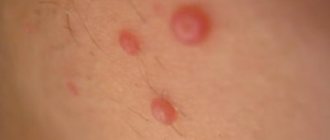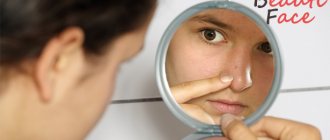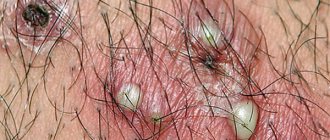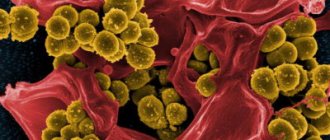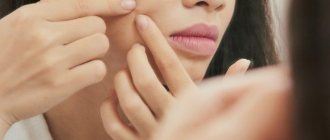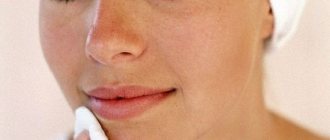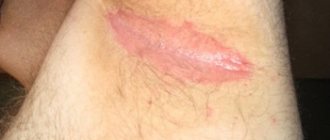What are red pimples?
Red pimples are unpleasant, inflamed growths that are filled with purulent contents. They can hurt, itch and cause discomfort to the patient, as well as cause a complex of psychological problems.
The inflammatory process begins due to the fact that the sebaceous ducts are clogged. Another common factor in the occurrence of such a pathological process is considered to be hormonal disorders, often observed in adolescence.
The main sign of this unpleasant phenomenon will be constant redness of the skin, the appearance of spider veins, and small purulent pimples. This disease usually affects people over 30 years of age, often females. However, when a similar difficulty affects men, he will suffer the disease much more severely.
Initially, slight redness of the skin appears, which does not cause anxiety in the patient. At the next stage, small red papules are formed. Each of the neoplasms contains a pustular pimple.
The papules can be very itchy and do not leave scars on the rash areas. The disease progresses in amplitudes, alternating between subsidence and exacerbation. After a certain period of time, thickened areas of the skin form in the areas where the acne was located, which later transforms into small bumps.
Red acne also appears against the background of various chronic diseases: gastritis, ulcers and other problems of the gastrointestinal tract.
Causes
The most common causes of red acne on the body are:
- Infectious diseases in childhood: rubella, measles, chickenpox, scarlet fever.
- vasculitis . Inflammation that occurs in the walls of blood vessels of the skin, resulting in the formation of a large number of small blood clots.
- Endocarditis is a disease that affects the tissue of the heart valves. One of the signs of this pathological process is red rashes, when pressed on, their shade does not change. Over time, the rash turns brown.
- Meningitis. Inflammation in the membranes of the brain, which is provoked by meningococcus. One of the early signs of this pathological process is the appearance of a red rash that does not disappear with pressure and protrudes above the dermis.
- Syphilis. One of the manifestations of this disease is a painful rash spread over the entire surface of the body and face, which over time transforms from red spots into dense purple bumps.
- Allergic rash. Formed as a result of allergies (often with food allergies).
- Scabies. Severely itchy red pimples are a manifestation of scabies, which is caused by mites.
- bites . Bites are identified by swollen red papules that have a small dot in the middle, appearing on the limbs or body. A tick bite is a small, burning bump that appears on the arms or legs after sleep.
Symptoms
The red rash is caused by excess sebum production that clogs the pores. It will become a breeding ground for microorganisms, and the skin on the nose, cheeks, chin and neck is often affected, and in rare cases on the back and genitals. After the rash, traces may remain, which cannot be quickly removed in all cases.
On this topic
- Pimples
13 ways to prevent acne
- Inna Viktorovna Zhikhoreva
- March 29, 2020
A subcutaneous red rash can appear at virtually any time. During their formation, a slight compaction is felt under the skin. When a pimple matures, a small bump of white, yellow or red color appears on the top layer of the skin. If you press it, the patient will experience pain. The inflammatory process is concentrated in different areas.
The red rash initially measures 0.2 cm in size. As inflammation develops, a pustule with pus forms inside the skin. It is a non-flesh-colored neoplasm protruding above the skin. Since these pustules are located under the skin, they are very difficult to eliminate.
Diagnostics
Red, inflamed rashes on the body indicate various diseases, so a visit to a specialist will make it possible to make an accurate diagnosis of the cause of the rash. Red spots may indicate an allergic reaction or some kind of infectious disease.
Sometimes a doctor will diagnose a rash after an external examination, but in general it is necessary to do several tests, for example, blood, a skin scraping or a smear. A comprehensive examination includes an external examination by a specialist, tests (including urine, blood and allergy tests), and so on.
These tests clearly show what type of infection the patient has, whether it is possible to eliminate this disease at home or whether hospital treatment will be required. Timely diagnosis contributes to the correct choice of therapy and speedy recovery.
Possible complications
With the wrong approach to treating this type of acne, there is a high risk of blood poisoning and tissue necrosis. To avoid serious consequences, it is imperative to consult a dermatologist.
Pimples like this can't be picked off.
A pimple with blood filling can be easily confused with other similar neoplasms. Hemangioma is very similar to a blood acne, but it is generally strictly forbidden to touch and remove it yourself. You should also be careful not to touch it. In the worst case, damage threatens to degenerate into a malignant neoplasm.
Treatment
To know how to get rid of a red rash, it is necessary to establish the provoking factors that caused its appearance. When it is just an inflammatory process on the skin, it can be eliminated quite quickly, and after 1-2 weeks there will be no trace of the disease. It is forbidden to squeeze pimples, as it may form a boil, which can later leave scars on the skin.
On this topic
- Pimples
5 ways to get rid of acne right now
- Inna Viktorovna Zhikhoreva
- March 29, 2020
Often, therapy for a red rash involves the use of complex medications for external use (Adapalene, Clenzit, Differin). Since they have a gel-like consistency, such drugs easily get under the skin and quickly have a bactericidal, anti-inflammatory effect.
For significant damage to the skin, the following medications are prescribed:
- antibacterial agents from antibiotics;
- systemic retinoids (Izotretinion) and topical drugs (Effezel, Izotrexin);
- hormonal agents estradiol;
- preparations ;
- locally acting drugs for external use (Levomekol, Clindamycin; Vishnevsky ointment; ichthyol, tetracycline ointments);
- wiping the skin with a 3% solution of salicylic acid;
- brewer's yeast, vitamin complex A, C, E, omega 3 and 6 fatty acids.
As an additional treatment for a red rash, it is permissible to use the following methods after completing the main treatment regimen:
- Ozone therapy. It gives positive results, harmful microorganisms are destroyed, sebum secretion processes are restored, and the size of scars after a rash is reduced. Redness and swelling are eliminated, and skin restoration is accelerated.
- Ultraviolet radiation eliminates pathogenic microflora and has a beneficial effect on rash treatment.
- Cosmetological measures (peeling, laser resurfacing, dermabrasion). They are not considered a therapeutic method for red acne, but can significantly stabilize the condition of the skin. After the procedures, microcirculation improves, skin elasticity increases, and recovery processes accelerate.
The method for eliminating the red rash is selected on an individual basis. It all depends on the rash itself, its location, and the type of skin. Before starting therapy, inflamed skin must be soothed and redness removed.
How to eliminate specific rashes?
Getting rid of bloody acne is only possible through physical therapy. The most effective include:
- laser therapy;
- electrocoagulation;
- ozone therapy.
Laser therapy is gaining more and more popularity every year. Laser beam treatment is successfully used in many areas, including it is very effective in the treatment of various types of dermatological diseases. Using a special laser device, the problem area is burned out. The procedure is completely painless and does not cause any side effects. Injury to the skin is minimal and complete healing occurs after a few days. However, despite the high level of safety, the procedure also has its own contraindications.
The laser procedure requires preparation
It is not performed for diseases associated with blood clotting disorders. In addition, before the procedure, the etiology of the neoplasm should be clarified. If it is malignant, laser therapy is not used.
Electrocoagulation is a cheaper way to eliminate bloody rashes, but no less effective. Using a special apparatus, the inflamed areas are burned out and immediately sealed to prevent infection from entering the wound. During the procedure, the patient may experience slight discomfort, which soon disappears. This method has all the same contraindications as laser therapy.
Ozone therapy is a highly effective physiotherapeutic method for removing various types of tumors. Under the influence of liquid gas at particularly low temperatures, problem areas freeze, which soon disappear on their own. The good thing about the procedure is that it does not cause any discomfort and is also classified as safe, provided there are no contraindications.
Prevention
Since eliminating a red rash is a complex process, it is better to prevent the disease than to treat it later. For these purposes, the following instructions must be adhered to:
- Do not touch the skin with dirty hands.
- Use only creams and decorative cosmetics suitable for a specific skin type. Keep an eye on their expiration dates.
- Apply cleansing tonics every day.
- If blackheads appear, perform auxiliary cleansing using special scrubs. Instead, it is also permissible to use mixtures of fine-grained salt and soda, mixed to a mushy state with water, and then applied to the affected areas. Rub them into the comedones with smooth massage movements, leave to act for 5 minutes and rinse off using warm water.
- After carrying out restoration procedures, make a mask that narrows the pores. She won't let them clog again.
- Monitor your own diet and do not overuse unhealthy foods.
- Quit smoking and minimize alcohol consumption.
- Walk more in the fresh air. Ultraviolet irradiation in small amounts has an antibacterial effect.
Daily care and home cleaning
It is important to follow the rules to completely eliminate red pimples. Before going to bed, be sure to wash off cosmetics from your skin and use mild cleansing gels or foams. After washing, the skin is wiped with lotion or tonic and lubricated with cream.
Inflamed formations can hurt, so you can lubricate them with antiseptic and drying solutions for faster healing
The covers need to be cleaned twice a week. The procedure is performed in several stages.
- First, the skin is steamed over a cup of hot water for 10 minutes.
- Next, a scrub or peeling is applied to the skin.
- After opening the pores, cleansing masks are applied.
- The final stage is the use of nourishing cream.
If there is inflammation, cleaning should not be carried out. It is also prohibited to squeeze out acne during this period. After a few days, the contents will come out on their own. If you do not wait and carry out removal, there is a high probability of scarring, staining and scar formation. If pus penetrates into the deep epidermal layers, extensive inflammation develops.
